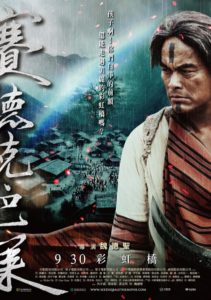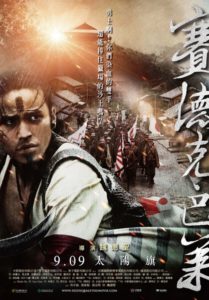Warriors of the Rainbow
赛德克•巴莱
Taiwan, 2011, colour, 2.35:1, 274 mins. (I: 143 mins; II: 131 mins).
Director: Wei Desheng 魏德圣.
Rating: 7/10.
Original, two-part version of the Taiwan epic is a substantial undertaking.
Taiwan. After the island is ceded by China to Japan in 1895, Japanese troops disembark at Jilong port to sweep the island clean of its aboriginal population and start exploiting its lumber and mineral wealth in the interior. They are initially beaten back by young warriors including Mouna Rudo (You Daqing), who has just attained manhood in the Mehebu Clan from Tgudaya, but they finally win the struggle, reducing the aboriginal population to forced labour. Thirty years later, in 1930, Mouna Rudo (Lin Qingtai) is now a clan chief of the Seediq tribe — based in central and eastern Taiwan — and head of Wushe village. There’s also been inter-marriage between Seediqs and Japanese, though the former are still treated as an inferior class. Aggravated by the  oppressive behaviour of a Japanese policeman, Yoshimura, Mouna Rudo’s people finally suggest an uprising, though initially only six of the 12 Seediq clans agree to join in. After a well-planned initial massacre of Japanese, and occupation of the Wushe area, the news is phoned down to the plain and the Japanese army moves in under Kamada Yahiko (Kawahara Sabu), a general.
oppressive behaviour of a Japanese policeman, Yoshimura, Mouna Rudo’s people finally suggest an uprising, though initially only six of the 12 Seediq clans agree to join in. After a well-planned initial massacre of Japanese, and occupation of the Wushe area, the news is phoned down to the plain and the Japanese army moves in under Kamada Yahiko (Kawahara Sabu), a general.
REVIEW
Not for the first time – remember Red Cliff 赤壁 (2008-09)? – the full-length, two-part version of a major Asian undertaking completely eclipses its shorter “international version”. Credited to Hong Kong editor Zhang Jiahui 张嘉辉 [Cheung Ka-fai], and running just over two-and-a-half hours, the latter premiered at the 2011 Venice Film Festival just over a week before Part I of the original opened in Taiwan, and drew a mixed response. Running almost two hours shorter than the original, four-and-a-half-hour, two-part version, it seemed to try to have it both ways: to still have an “epic” feel with a sizeable running time and to still pack in as much of the big stuff as possible. The result was a movie that focused too much on warfare at the expense of character and narrative clarity. [See separate review, Warriors of the Rainbow: Seediq Bale (2011).]
Almost all of that version’s weaknesses are non-existent in the original version, Warriors of the Rainbow 赛德克•巴莱, released in Taiwan in two separately titled parts: Warriors of the Rainbow I: Sun Flag 赛德克•巴莱 太阳旗, which ends with the so-called Wushe Massacre 雾社事件 of Japanese colonisers by Taiwan aborigines, and Warriors of the Rainbow II: Rainbow Bridge 赛德克•巴莱 彩虹桥, which, after a quick recap of the story so far, picks up events on that same morning, 22 Oct 1930.
Part I, which runs almost as long as the whole international version, is a considerable movie in its own right: there’s a proper dramatic build-up to the massacre, not only on the misty morning in question but also on a broader time-scale, in the events leading up to it. With just over an hour of screen time devoted to life in and around Wushe prior to the massacre, the social structure emerges with more clarity, with aborigines who have adopted Japanese names and lifestyle (such as Hanaoka) and sympathetic Japanese represented by Kojima, played by Ando Masanobu 安藤政信. In every way, as well as in the differences between the aboriginal clans and their leaders, the story is easier to understand and gains in motivation, ending with a real punch with the massacre itself.
Because the characters are better established, the numerous scenes of jungle warfare in Part II no longer seem repetitive, especially as the connecting material between them is still there. There’s a fullness and sense of structure to each of the battles that’s missing in the international version. The symphonic score by Singapore’s He Guojie 何国杰, heard in full, seems especially well tailored to the movie.
On the debit side, there’s still way too much talk of eternal hunting grounds and crossing the rainbow bridge; in places, the visual effects still seem cheesy, and unworthy of the production’s scale and ambition; and Part II shows a reluctance to end, especially with a long sequence of women looking for their husbands on a battlefield, and then with several postscripts that continue even into the final credits. Also, the whole film could still do with more humour, and a greater sense of geography and place.
Despite those weaknesses, Warriors of the Rainbow is a production – especially in Part I – that has a genuine epic breadth and sense of occasion in its full version. With Part I rating a noble 8/10, and Part II a lesser 6/10, the whole movie aggregates out at an impressive but not knockout 7/10. It well deserves, like the original Red Cliff, to be shown long after the “international version” has done its immediate business and been forgotten.
CREDITS
Presented by Central Motion Picture Corporation (TW), ARS Film Production (TW). Produced by ARS Film Production (TW).
Script: Wei Desheng. Photography: Qin Dingchang. Editing: Chen Bowen, Su Peiyi. Music: He Guojie. Production design: Taneda Yohei. Art direction: Akatsuka Yoshihito. Costume design: Qiu Ruolong, Deng Liqi, Lin Xinyi, Du Meiling. Sound: Du Duzhi. Action: Yang Gil-yeong, Shim Jae-weon. Visual effects: Hu Shengzhong (Beijing Crystal Film & Media). Production advice: Dakis Pawan.
Cast: Lin Qingtai [Nolay Piho] (Mouna Rudo), Ma Zhixiang [Umin Boya] (Temu Walis), Ando Masanobu (Kojima Genji), Kawahara Sabu (Kamada Yahiko, general), Xu Ruoxuan [Vivian Hsu/Bidai Syulan] (Takayama Hatsuko), Luo Meiling [Yokuy Utaw] (Kawano Hanako), Wen Lan [Yungai Hayung] (Mahung Mouna), You Daqing [Yuki Daki] (young Mouna Rudo), Zeng Qiusheng [Pawan Nawi] (Rudo Luhe), Tian Jun [Yakau Kuhon] (Tado Mouna), Li Shijia [Pawan Neyung] (Baso Mouna), Lin Yuanjie [Umin Walis] (Pawan Nawi), Zhang Zhiwei (Pihu Sapu), Xu Yifan [Bokeh Kosang] (Hanaoka Ichiro/Dakis Nawi), Su Da [Soda Voyu] (Hanaoka Jiro), Kimura Yuichi (Satsuka Ayu), Ma Rulong (owner of trade centre), Tanaka Chie (Kojima’s wife), Zheng Zhiwei [Pihu Nawi] (Wu Jindun).
Release: Taiwan, 9 Sep 2011 (I), 30 Sep 2011 (II).
(Review originally published on Film Business Asia, 6 Nov 2011.)
